Water Drainage Issues
One of the more common issues we hear from homeowners is how to deal with standing water? If there are parts of your yard where water seems to stand and you’re not sure why, you need to give us a call.
Standing water in a yard, next to a foundation or around your driveway is more than just unsightly, it’s going to cost you money if it is allowed to stay where it is and not properly drained off. If you see standing water or really moist or soggy spots in your yard there may be a drainage issue.
Beyond being unsightly, drainage issues can kill your grass or sod, cause mud to be tracked all over your yard or into the house, and can become a magnet for breeding mosquitoes. When water doesn’t drain out of the yard it can create serious erosion damage to the yard and potentially compromise all of your hardscape, including foundations, walkways or driveways.
Water drainage issues typically fall into one of several categories habit-based, material-based, or design-based. The easiest category to fix is habit-based. Basically it means you the homeowner are doing something that is either causing or accentuating the water drainage issue. For example if you have a sprinkler system, “are you watering every day for three or four hours?” Something as simple as going to an every other day schedule could fix your issue by giving your soil and planting areas a chance to absorb the moisture. When it comes to watering a healthy lawn, more is not always better.
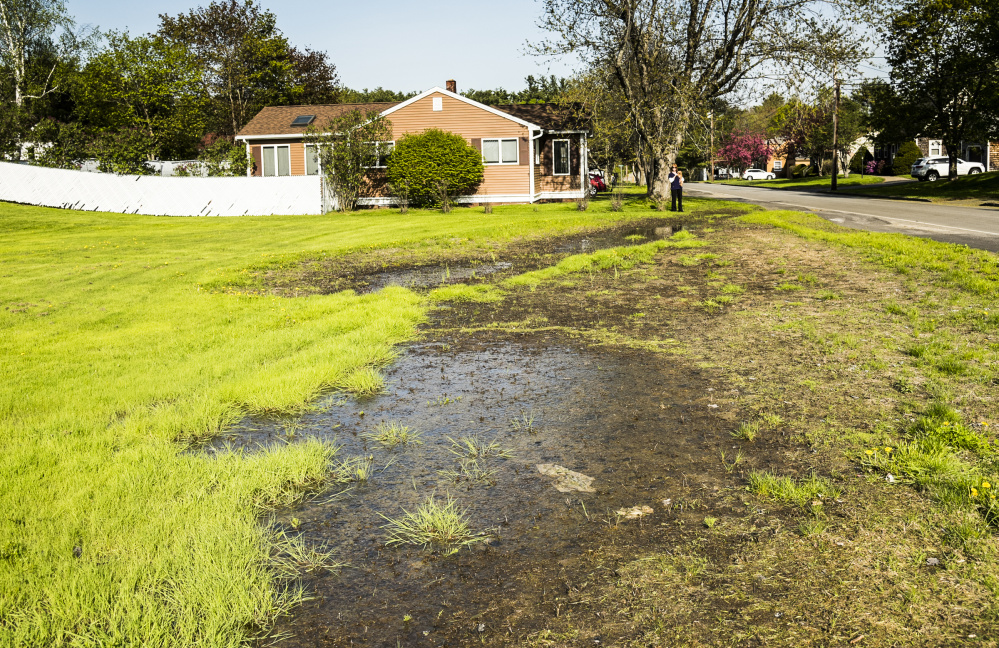
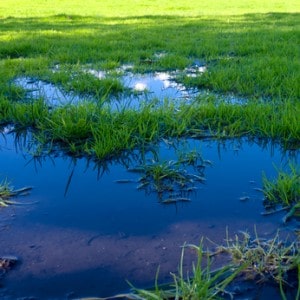
Material-based water drainage issues are a little more complex. For example, if you have a planting area next to the foundation with rocks or mulch separated by a stone curb you may have inadvertently created a water basin that is holding water in that top 6 to 8 inches of soil just under your rocks or mulch. The use of fabric materials or plastic to stop weeds can significantly increase water drainage issues. The solution might be as simple as punching holes through your barrier fabric allowing water to escape.
Design-based water drainage issues are the most complex. They usually require some substantial redesign of your existing landscaping. When we look at modifying or redesigning your landscape there are a handful of techniques we can employ to permanently resolve your water drainage issues.
Yards with high amounts of clay soil suffer problems with lingering surface water. In theory lots are always graded so the water drains away from the foundation and through swales in the yard out to a storm sewer, or someplace where the water can easily flow away from the property. Most builders do a very good job at water mitigation. We all want a lawn that looks good and creates some visual interest. It’s easy for someone doing the original grading of a property to be an inch or two high or low as they create swales in the lawn. Often it’s a combination of grading, sod thickness and plants that combine to create an issue, which is something that the original builder could never see.
Water Drainage Issues & Solutions
Grass Swales
A grass swale is an area of the lawn that is carefully graded to force water in a predetermined direction or area. Often well designed swales are almost undetectable to the casual viewer. Swales can be as gradual as one inch over ten feet, and others might look more like a golf course. It is probably a pretty good bet that your lawn already has several grass swales and we will definitely consider adding and modifying existing swales if you call us to help with your water drainage issues.
French Drains
French drains have been used for thousands of years. Considered one of the most well-known types of drainage systems, French drains consist of a trench that is filled with large rocks and gravel then covered with landscaping fabric, soil and sod. Today we often use a perforated pipe, called a “ductile” that is surrounded by gravel and wrapped in landscaping fabric to keep soil out of the pipe. French drains direct water away from foundations, retaining walls, and low spots in the lawn to keep your landscaping healthy. One of the main reasons French Drains or ductile systems are so popular is while they remove most of the water they do allow for some water absorption in the nearby soil.
Trench Drains
Trench Drains are usually only employed in severe water drainage cases that require a lot of water to be removed from an area very quickly. Trench drains are usually lined with concrete and sloped to remove the water quickly not letting it be absorbed by nearby soil. Steel grates and other filters can be used to cover the trench drain to keep it from getting clogged with debris. Trench drains are excellent when dealing with excess water runoff from parking lots, large driveways and patios with pools.
Bog Areas
Bog Areas use all of the techniques previously mentioned to direct water to design low space in the lawn. Careful planning and the correct plants can make a Bog Area an attractive addition to your lawn and create a safe place to collect excess rain water away from people and usable areas of your patio or lawn. Bog Areas are typically considered when allowing excess water to flow from the property is not a reasonable, safe or legal option.
Dry Well Systems
Another option for collecting excess water is a dry well system, which is a large underground storage tank that can collect excess water. Depending on your preference the collected water could be reused to feed your sprinkler system or the water could be allowed to gradually seep out of the holding tank back into the water table.
Downspouts
A very common issue property managers and home owners struggle with are downspouts that don’t have any place for the water to drain. Most of the time we can fix the issue with a swale or French drain type system.
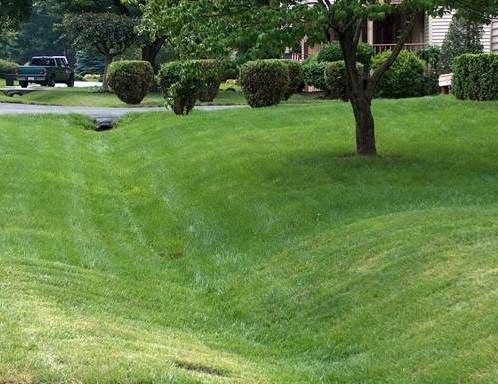
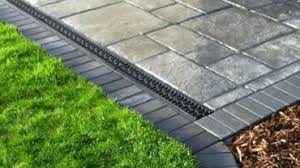
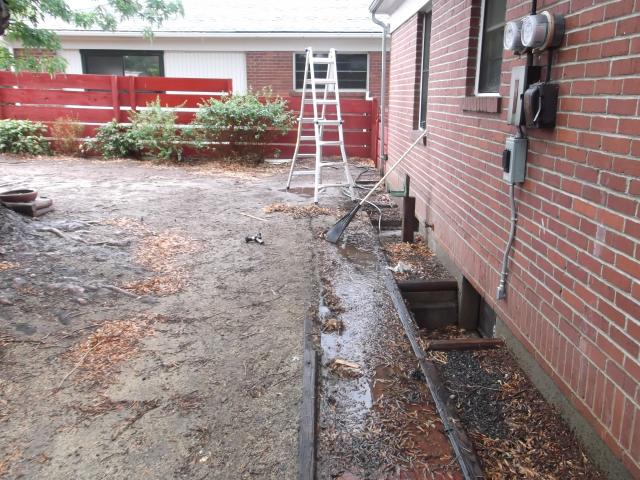

Our Services
Retaining Walls
A timeless landscape feature, retaining walls built in the Omaha, Council Bluffs area are a classic mixture between form and function. Perfect for creating flat space, featuring srubs and flowes and protecting your home from excess moisture.
Patios - Outdoor Living
Your patio is a perfect place to relax, entertain guests and enjoy nature all year long. Pavers, colored and stamped concrete, natural stone are all possibilities for your next patio and outdoor living area. We'll help you design and build the perfect patio for your home.
Sidewalks & Walkways
Cracked, crumbling and uneven sidewalks and walkways create a safety hazard, and negatively impact the value of your home. Our team of concrete professionals can help you diagnose why your driveway or walkway has damage and recommend the best solution, including repairs, or replacement.
Outdoor Kitchens & Fire Pits
Just like the Kitchen is the center of your home indoors, your outdoor kitchen and fire pit are the center of your outdoor patio and living space. Family and guests will congregate around a natural stone or engineered paver outdoor kitchen and fire pit.
Excavation Services
Specializing in Residential Excavation Services we understand that it takes the right tools and operators with residential site experience to get the type of outcomes most homeowners are looking for. We right size the equipment to fit the size of your job.
Commercial Lawn Maintenance
We are lawn maintenance and mowing professionals that are trained, licensed and insured in both Nebraska and Iowa. Customers satisfaction is our number one goal. Commercial lawn maintenace and mowing services in the Omaha, Council Bluffs metro area.
